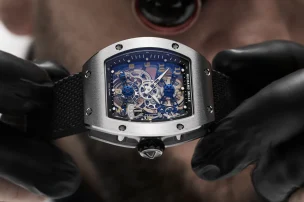

Everything You Need to Know About The Rolex Submariner
In Lewis Carroll’s Alice in Wonderland, the King gives the White Rabbit some sage advice for storytelling: ‘Begin at the beginning,’ the King said gravely, ‘and go on till you come to the end: then stop.’ That’s exactly the plan for this ultimate yet digestible guide to the Rolex Submariner. Rather than filling this space with numerous overwhelming details, Swisswatches presents you with the lowdown on Rolex’s most sought-after model today, as well as key moments on its journey.
The history of the Rolex Submariner
The early 1950s: The birth of the Submariner
The first Rolex Submariner officially launched in 1954 in the form of the Ref. 6204 at the Basel Watch Fair. As with all watch icons, though, there’s a fair bit of context behind it. In the late 1940s, diving began to take off as a sport. Rolex was well-equipped for the rise of tool watches, having patented its famous Oyster case way back in 1926, as well as gaining knowledge through its work with Italian concessionaire Officine Panerai, which was making waves with its Radiomir watches designed for the Italian navy.

Panerai Rolex Radiomir, Ref. 3646, from the 1940s
Credit: Sotheby’s
By the early 1950s, tool watches were coming into their own. The Explorer was spreading its wings from 1953 onwards (although it did not yet bear the name on its dial), as was the lesser-known Ref. 6202 Turn-O-Graph (bearing many similarities to the Submariner and marking the first serial Rolex model to have a rotating bezel).
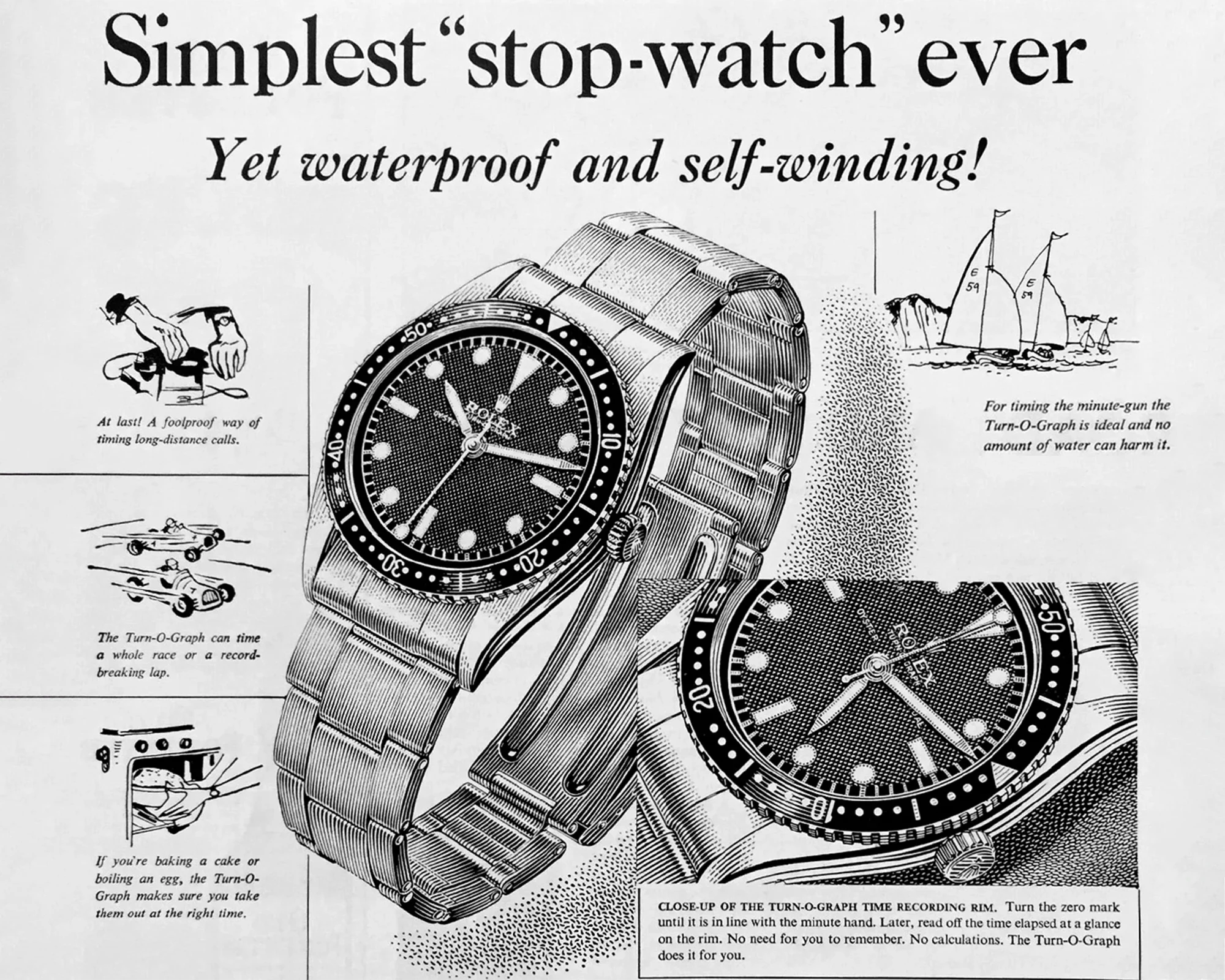
Three individuals’ names often crop up when the conception of Rolex’s first professional diver’s watch comes up: founder Hans Wilsdorf, who took a great interest in the segment, professional diver and oceanographer Jacquet-Yves Cousteau, and underwater explorer René-Paul Jeanneret, who sat on the company’s board of directors. Noticing the rise in interest of underwater sports, it was the latter who first put forth the suggestion of creating a Rolex that was both durable and attractive.

Jacquet-Yves Cousteau
Credit: Cine Text/Sportsphoto/AllStar
This melting pot of diving expertise, horological know-how thanks to its long-employed use of the Oyster case, insights from Panerai, and a penchant for design enabled the first Submariner to quickly take shape. Throughout 1953, early versions of the model labelled the Ref. 6200 were put through their paces on land and in the ocean, with the watch being put to the test in depths up to 120 metres with varying levels of force. Corrosion, temperature, and humidity were carefully monitored with the help of the L’Institut Océanographique de Monaco. Despite the watch not yet integrating crown guards – this would not happen until 1959, when the Submariner would grow from 37 mm to 40 mm in diameter – and even being plunged into water with the crown pulled out to the time-setting position, the watch performed phenomenally, with no traces of water found inside.
A Reference 6200 from 1954
Credit: Phillips
This culminated in the launch of the first Rolex Submariner at the watch fair in Basel in 1954. Defining this all-important Submariner model was its graphic matt-black dial with its upside-down triangle at 12 o’clock, luminous hands and baton indices at 3, 6 and 9, dot indices, and a black, gilt-finish rotating bezel. At its launch, a simple slogan accompanied the watch: ‘Submariner – the diver’s friend.’ That said, many early editions did not explicitly feature the word ‘Submariner’ on the dial, earning the nickname ‘Clean Sub’ – while some early British models even omitted the word ‘Submariner’ in favour of ‘Sub-Aqua’.

A very rare Rolex Sub-Aqua reference 6204 from 1954 in stainless steel
Credit: Monaco Auction Legends
Evolution of the Submariner
The first Submariner (Ref. 6204) was equipped with a rotatable graduated bezel to display immersion and decompression time, plus water-resistance to 100 m. Rising to 200 m a mere year after its launch, this was eventually followed in 1979 by today’s water-resistance (300 m).

The practical Oyster Perpetual Submariner is known as the first diver’s watch to be
water-resistant to 100 m.
The 6204 is much slimmer than the pieces we have today, not to mention in possession of a smaller crown, measuring a mere 5.3 mm. Powering the watch was Rolex’s in-house automatic calibre A260 with shock protection. Despite being taken from earlier Oyster Perpetual models, it was the horology house’s hardiest movement at the time. Notably, the 6204 lacked the recognisable Mercedes hour hand; first appearing on the Explorer in 1953, this key characteristic would not appear on the Submariner until 1954, when it was officially introduced to the general public at Baselworld.

A watch destined for action: Changes to the bezel
In the post-war 1950s and 1960s, the users of Rolex tool watches included astronauts, divers and explorers alike. Even the British Royal Navy joined forces with Rolex, wearing models such as the Submariner Ref. 6538 as early as 1955.

A reference 6538 ‘Big Crown’ Submariner from ca. 1958
Credit: Sotheby’s
A year later, Rolex’s Ref. 6536 integrated a rotatable bezel with single-minute calibrations for the first 15-minute segment, as well as a zero-point triangle. Unidirectional bezels, however, would not become a design feature until 1981.

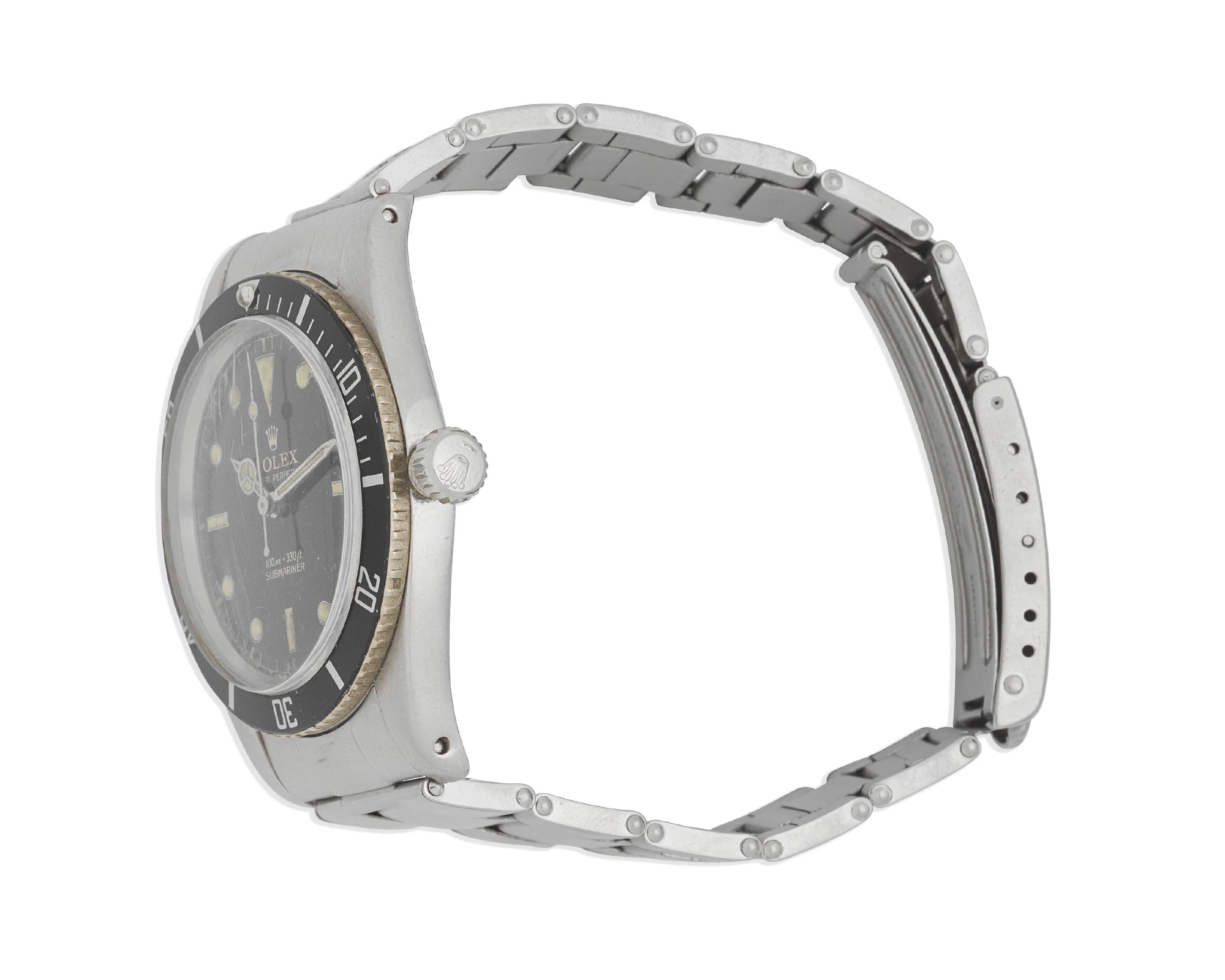

Rolex Submariner with gilt gloss dial, Ref. 6536, ca. 1957
Credit: Bonhams
Rise of the Submariner: Sean Connery as James Bond
Ref. 6538: A collector favourite
A literary aficionado of Ian Fleming’s James Bond novels will know that the spy wears what is described as a ‘heavy Rolex Oyster’. When Sean Connery donned the watch in 1962’s Dr. No, though, we saw a serious diver’s watch which was being used mainly by professional divers. In Dr. No, Connery appears wearing the Submariner ‘Big Crown’ Ref. 6538 – a fitting name for this particular model. In addition, it’s worth noting that the 6538 lacked crown guards.

A Submariner Ref. 6538 with 4-Line “Tropical” dial and bracelet, circa 1958
Credit: Sotheby’s
The pivotal 6538, which Connery would popularise forever more, was first launched in 1955 and already had some key differences in comparison to the original. This included a new calibre 1030 movement, a thinner case, more beveled lugs, and the aforementioned large crown.

Calibre 1030
Credit: Sotheby’s
Interestingly, the 6538 also marked the first Submariner to advertise the COSC certification on the dial. Given that the production ended in 1959, this reference remains pretty rare today. This reference is hugely important not only as a collector’s item, but also because of Connery’s role in making the Submariner the famous timepiece we know and love today, as it went on to spark a succession of other Submariner-wearing Bonds.

Sean Connery as James Bond in Goldfinger (1964)
The same 6538 model stays on Connery’s wrist in From Russia With Love, Goldfinger, and Thunderball. His successor George Lazenby also wears the 6538, while the Submariner Ref. 5513 makes an appearance in His Majesty’s Secret Service. Roger Moore dons the same reference in Live and Let Die and The Man with the Golden Gun. In a final comeback, Timothy Dalton is thought to be wearing the Submariner Ref. 16610 in 1989’s Licence to Kill. Eventually, Bond defected to Omega – and you can read all about that here.
Left: A ‘Milsub’ Submariner, Ref. 5513, made for the British Royal Navy in ca. 1975
Right: An ‘Explorer Dial’ Submariner, Ref. 5513 with gilt exclamation point dial, ca. 1962
Credit: Left: Sotheby’s, Right: Sotheby’s
The importance of Bond
Bond’s choice of watch did more than capture the attention of admiring men. As discussed in our ever-popular Submariner: Date or No Date article, it also famously proved to millions of people (consider the fact that 47 percent of America’s population has seen a Bond movie) that the Submariner could serve both a man of action as well as a man of style. If Bond can wear it just as suavely diving under a yacht as in a tuxedo at a casino, your average insurance broker can surely pull off just as well wearing it to the office. Prices for the 6538 Submariner, first seen on trend-setter Connery, have soared over a million dollars in recent years.
Special models: Other important Submariner models
While we’ve tried to condense things as much as humanly possible, you’ve no doubt surmised that over the years, particularly in its earliest stages, there were numerous iterations of the Submariner as Rolex experimented to create the perfect design. Going through the endless early iterations and their many differences can prove downright chaotic. As mentioned, there are ‘clean’ dial iterations without the word ‘Submariner’ on the dial, changes in font size for the word ‘Oyster Perpetual’, spacing changes, and as touched upon, the initial ‘pencil’ as opposed to ‘Mercedes’ hour hand. In terms of materials, the first gold Submariner appeared in 1969 in the form of the Ref. 16618, underlining the professional timepiece’s ‘daily watch’ status. Coloured bezels slowly began to creep into the collection – and these colourful editions have captured fans of the iconic watch in recent years.

The ‘King Sub’ 6200
One variation of particular interest to collectors is the aforementioned iteration of the Ref. 6200, also dubbed in collector circles as the ‘King Sub’ or ‘Explorer Dial Submariner’. This coveted piece, like the Explorer models, uses Arabic numerals at 3, 6, and 9 o’clock, and larger 8 mm crown. While its siblings the 6204 and 6205 are water resistant to 100 m, the 6200’s 37.5 mm case promises water resistance up to 200 m.

A ‘possibly unique’ Ref. 6200 with ‘Explorer’ dial, ca. 1954
Credit: Phillips
The Kermit
Back in 2003, Rolex celebrated 50 years of the Submariner with a special Submariner model featuring a date function and bezel with a green aluminium insert. This was big news, given how rarely the colour, let alone the company’s emblematic colour green, makes an appearance in the line. Known officially as the Ref. 16610LV, the Rolex community promptly renamed it Kermit after the frog-like everyman protagonist of the Muppet Show. A little expert detail gained from Gisbert Brunner’s definitive The Watch Book – Rolex: the ‘LV’ in the reference number stands for Lunette Verte (French for ‘green bezel’).

‘Kermit’: Ref. 16610LV
Credit: Sotheby’s
The Hulk
Perhaps one of the best-known, most coveted Submariner pieces for Rolex fans today is the unmistakable ‘Hulk’. First appearing at Baselworld back in 2010, it features not only a green bezel, but also a matching green dial. Known officially as the Ref. 116610LV, it was produced for an entire decade. While the initial retail price was only around 9,050 US dollars, the price today on the pre-owned market starts at around 30,000 US dollars. This is partly because the model was discontinued in 2020, in order to make way for a new green bezel watch, the 41 mm Ref. 126610LV. This newer iteration features a green Cerachrom bezel and a black dial, so its popular nicknames thus far include ‘Ceramic Kermit’ and ‘Super Kermit’.
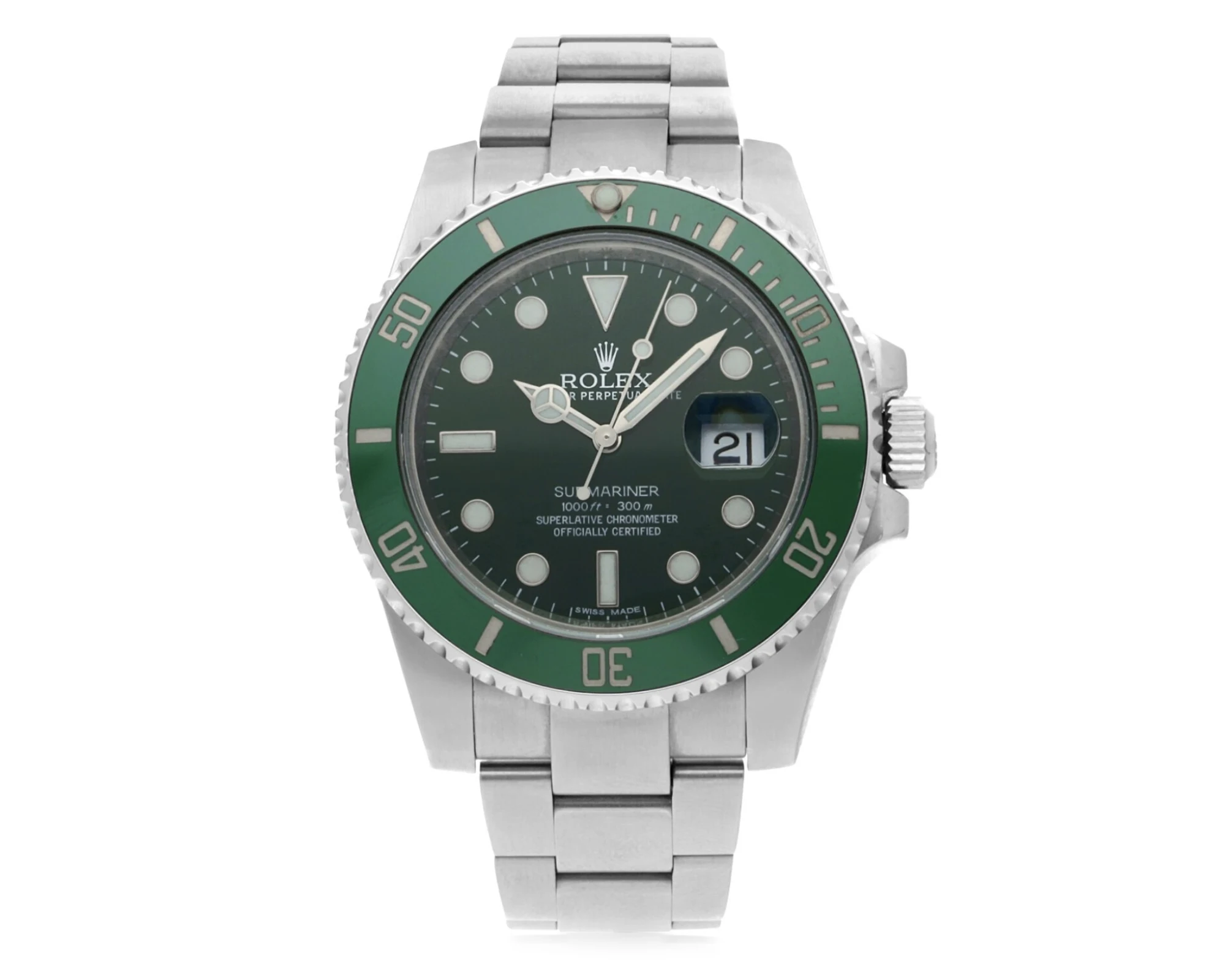
‘Hulk’ Ref. 116610LV
Credit: Sotheby’s
The Submariner and the date function
As mentioned, to really go into depth about the difference between Date or No Date models, you should take a look at our highly detailed article on the topic. To summarise it briefly, this entirely depends on taste. Which appeals to you personally? Are you a purist or a pragmatist? It’s all up to you. In any case, the modern Submariner ‘Date’ uses the calibre 3235, featuring an instantaneous date complication with rapid setting.

Calibre 3235
Historically speaking, there were no models with a ‘date’ function until 1969, when Rolex launched the Ref. 1680. As the legend goes, Rolex’s founder was inspired to create the ‘Cyclops lens’ date window feature after a drop of water fell onto his watch in the bathroom, magnifying what lay beneath. When Rolex finally introduced the date to the watch, it had been manufacturing an automatic movement with date for almost 20 years. This implies that Rolex, too, was not always convinced about adding an everyday complication like a date to a watch that was first and foremost ‘Professional’. The decision to add a date well and truly made the Submariner a hybrid watch, both for action, style, and practicality – let’s remember that 1969 is the same year gold entered the collection for the first time, too, on the Ref. 16618.

Ref. 16618
Credit: Phillips
The modern Submariner: Why is it so popular?
Today, the world remains obsessed with the Submariner. Why? Aside from its history, the most obvious reason in my opinion would be is its recognisability. Fun (or depressing) fact: roughly 75 percent of all counterfeit watches are fake Rolex models, and it is fair to assume that many of these are Submariners, as the brand’s most popular model. In a world of social media and the incredible popularity of designer clothing, the Submariner is, inevitably, a status symbol above all else. It shows an ability to afford and attain an excellent watch from the world’s top watch brand. Of course, that isn’t to say that many aren’t enticed but the watch’s prestigious history, achievements, high quality and functionality – but ultimately, its iconic design plays a crucial role in its success. With that in mind, we true enthusiasts take a look at the defining technical and aesthetic features of the modern Submariner, with the latest generation having launched in 2020.

The Submariner case
2020 marked the start of a redesigned Submariner case, with a very slightly larger diameter of 41 mm (previously, the case had long been 40 mm). The Oyster Perpetual case consists of a monobloc middle case and screw-down caseback. It is pretty tough, designed to keep out not only water up to 300 m (1,000 ft) but also to resist shocks, pressure, and dust.
The crown
The screw-down winding crown is also worth a mention. Over the years, the crown size has varied, from 5.3, to 6, to 7, to 8 mm. While crown guards are not present on every single vintage model, they became a permanent fixture from 1962 onwards. Today, the watch has a Triplock winding crown, fitted with a triple water-resistance system, which screws down against the case for additional protection.

The material
Then there’s the material: your typical Submariner, and my opinion the best Submariners, comes in sporty material called Oystersteel. Rolex uses Oystersteel for all of its steel watch cases. Specially developed by the brand, Oystersteel belongs to the 904L steel family, alloys most commonly used in high- technology and in the aerospace and chemical industries, where maximum resistance to corrosion is essential. Oystersteel is extremely resistant, offers an exceptional finish once polished, and maintains its beauty even in the harshest environments. That said, other materials available in the current collection include yellow gold and white gold, as well as bi-colour editions comprised of yellow-gold and Oystersteel.

The bracelet
The modern Submariner always uses Oyster bracelet, which comes with three-piece solid links and secures to the wrist using an Oysterflex clasp. This innovation provides the vital function of preventing an accidental opening, meaning the watch is secure on diver’s wrists – and the rest of us likely also wouldn’t want a Rolex slipping off our wrists, either. Rolex also incorporate the company’s Glidelock extension system. This allows for fine adjustments of the bracelet without the need for any tools, meaning it can be worn over a diver’s suit and adapted as necessary.

The dial and date
The Submariner, with its tool watch DNA, is all about readability. That’s why the hour markers on the dial come in such simple shapes – triangles, circles, and rectangles. Likewise, the iconic broad Mercedes hour hand and long minute hand also enable instant and reliable reading to prevent any risk of confusion when underwater. Of course, the watches also use luminescence for 24/7 and underwater readability. Interestigly, the majority of new watches came with a date function, all aside from one piece – the purist Ref. 124060. This arguably indicates how popular the watch is as an everyday piece today. The date lies at the traditional 3 o’clock position, with the classic Cyclops lens making it all the more legible.

The bezel
The bezel is the most important part of a diver’s watch. Its 60-minute graduations allow divers to accurately and safely monitor diving time and decompression stops. On the modern Submariner, we have a unidirectional rotatable 60-minute graduated bezel. In 2020, we saw an array of new coloured models, alongside new coloured Cerachrom bezel inserts. This included several blue bezels, a green bezel, and a few in black, too. Cerachrom, by the way, is a scratch-proof, fade-proof ceramic alloy, in use at Rolex since 2005, first appearing in the GMT collection.

In order to set the size time with as much ease as possible, the Submariner bezels have knurled edges and rotate notch by notch, with satisfyingly distinctive clicks accompanying it. Rolex place a ‘Chromalight capsule’ on the zero marker, allowing for visibility even in the darkest depths of water.
The calibre
The new generation Submariner is powered by the calibre 3235 (with date function), which holds no less than 14 patents, or the calibre 3230 (a version without date function). Both were first introduced into the 2020 models. Both offer a 70-hour power reserve and incorporate Rolex’s ‘Chronergy’ escapement. This special escapement enjoys an excellent reputation thanks to its efficient and reliable performance. Made of corrosion-resistant nickel-phosphorus, it is insensitive to magnetic fields.

Furthermore, both movements use an optimised blue Parachrom hairspring. This makes it 10 times more precise than a traditional hairspring in the case of shocks. The blue Parachrom hairspring’s inclusion of a Rolex over-coil ensures regularity in any position. Finally, the oscillator’s positioning on Paraflex shock absorbers increases the movements’ shock resistance. The calibre 3235 and 3230 both demonstrate Rolex’s continually excellent, reliable and technologically advanced watchmaking abilities. So reliable, in fact, that the watch deviates a mere -2/+2 seconds per day.
Rolex is known for walking not running when it comes to evolving its products – thus, I would argue that the Submariner movements are not likely to see much of a change in the years to come. As the saying goes: If it ain’t broke, don’t fix it.
COSC certification – what is it?
This solid sense of reliability is one of the reasons that the Rolex Submariner calibres tend to be COSC certified – a prestigious independent certification that indicates a watch’s high quality. COSC stands for Contrôle Officiel Suisse des Chronomètres, or the ‘Official Swiss Chronometer Testing Institute’. The institute checks the accuracy and precision of Swiss watches through a range of stringent tests, which ensure that the watch doesn’t vary too much under, for example, high pressure, temperature, or change of position. Unsurprisingly, the vast majority of Rolex watches are COSC-certified, not least since the turn of the century – but not all.
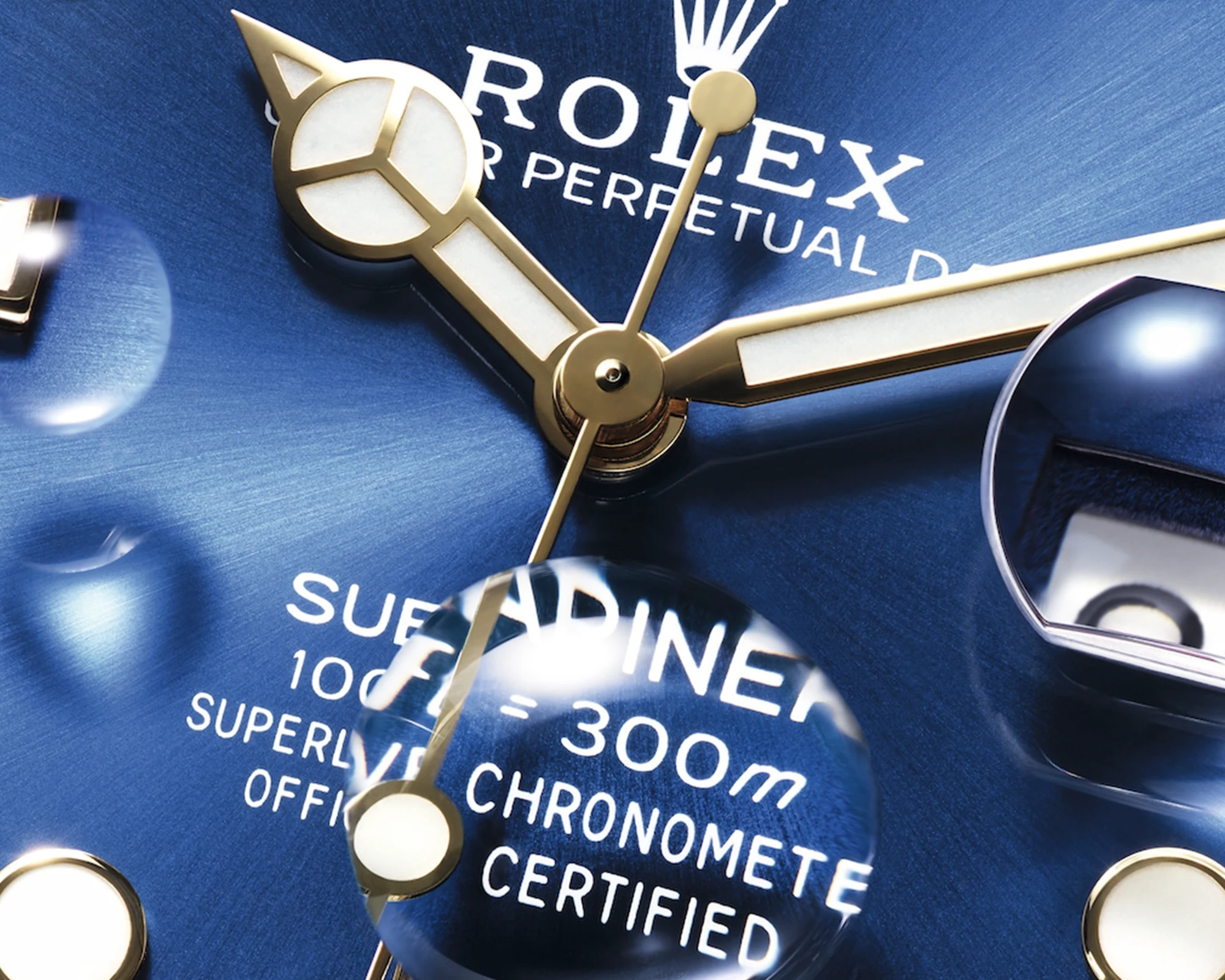
Several vintage Submariners are not certified. This includes the Submariner Ref. 5513, which Rolex introduced as a more affordable version of the Ref. 5512 in the early 80s. While very similar in terms of aesthetic, the former used a different, non-certified calibre. Its successor, the ‘No Date’ Submariner Ref. 14060, is best known as the first of its kind to have a sapphire crystal (as opposed to plexiglass), Triplock winding crown, and water resistance to 300 meters. However, it was powered by the calibre 3000, which is not a certified chronometer movement. From the early 1980s with the Ref. 5512 up until 2007, there were actually no COSC-certified ‘No Date’ Submariners – something worth thinking about for collectors on the look-out for a vintage Sub.

Submariner Reference 14060, ca. 1995
Credit: Sotheby’s
Who wears a Rolex Submariner?
Need some inspiration to decide if this is the watch for you? Then let’s look at some role models known to wear the world’s most iconic watch. Actor Jack Black discards the traditional material Oystersteel in favour of an 18-carat white-gold Submariner Ref. 116619, paired with a blue Cerachrom bezel and blue dial. This watch also has a nickname: ‘Rolex Smurf’. It’s a pricey option, often going for around 40,000 US dollars or more. Elsewhere, American actor Justin Theroux opts for a vintage Submariner from 1971, the Ref. 1680, a yellow-gold reference with a black bezel and dial.

‘The Smurf’ Ref. 116619LB, ca. 2008
Credit: Phillips
The Sub is not limited to men, though, what with the ongoing trend of women to wear men’s models – perhaps they’re sick of sized-down, diamond-clad iterations of historic horological icons. American actress Sharon Stone is one famous wearer of the Rolex Submariner, with the sultry combination of a black dial and black bezel. Ellen Degeneres wears a very rare 38 mm Rolex Submariner ‘James Bond Big Crown’ Ref. 6538.
What should I wear with a Rolex Submariner?
If we’ve learned anything, it’s that the Submariner is a pretty flexible watch when it comes to style. There aren’t really any ground rules. Ultimately, it works with business or casual wear, and only the most staunch of purists might say otherwise. When it comes to this watch, you can express your own style pretty much however you like, and it should still fit pretty easily to whatever look you decide to go for.

How much is a Rolex Submariner?
As explained, rare, discontinued and vintage models can go for rather a lot, and prices can vary hugely, up to around 40,000 US dollars. However, the latest generation Rolex watches’ list price starts at 9,150 US dollars. It can even be cheaper to buy a modern Submariner than an old model. It really tends to be the Daytona models that cause a frenzy at auction – something you can delve into here.
The Rolex Submariner versus its competitors: What is the Rolex Submariner up against?
The Rolex Submariner is obviously an icon in its own right, so there isn’t necessarily competition. However, there are some alternatives for those wanting something either less ostentatious, if you will, than a Rolex, or wanting something more affordable. Of course, this list is by no means exhaustive, so these are just a few of the other options out there.
Omega Seamaster
Perhaps the most obvious alternative to a Rolex Submariner is the Omega Seamaster. As well as also being water-resistant to 300 m, it is another watch to immortalised by Bond – even more so than the Submariner. In fact, Bond has solely worn Omega watches (for the most part, the Seamaster), since 1995’s GoldenEye featuring Pierce Brosnan as 007.
Tudor Black Bay
Alternatively, Rolex’s sister brand Tudor has strong ties to the Submariner. A mere year after Rolex launched the first Submariner model, Tudor introduced its own diver’s watch: the Oyster Prince Submariner Ref. 7922. Today, the watch lives on in the form of the Black Bay and the Black Bay 58 divers watches. To find out the entire story behind the Tudor Submariner, we’ve got you covered with an in-depth article here.

Breitling SuperOcean
Breitling’s SuperOcean is another diver’s watch that has gained a large and faithful following in recent years. The contemporary-looking watch has actually been on the scene for almost along as the Submariner, proving popular since its conception in 1957. Created specifically for professional and military divers, it wasn’t long before this watch proved popular with the general public. With some models now water-resistant up to 300 m (and its 1950s/60s Deep Sea models went to 1,000 m), it is available in many different sizes, meaning there’s something out there for everyone. The smallest version comes in 36 mm, while the largest measures a hefty 48 mm in diameter.

Oris Aquis
Independent Swiss watch manufacture Oris’ Aquis has been a hot topic in recent years, not least since the diver’s watch got a calibre update a couple of years back. The still relatively new calibre 400 has an unusually long power reserve of 5 days. The other big bonus of these watches has to be the mesmerising sunburst dials, which comes in blue, green, or black, with matching bezels. Like the Submariner, the Aquis is water-resistant to 300 m. Oris’ Divers Sixty-Five 12H Calibre 400, with its legible dial and trusty movement, also makes for a nice affordable alternative and is not too far off from the Submariner in the looks stakes.

Blancpain Fifty Fathoms
Finally, the Blancpain Fifty Fathoms is one of the most respected diver’s watches out there and also often cited as the first of its kind. Blancpain claims to have first launched its own diver’s watch in 1953, although some dispute this date by a couple of years. ‘Fifty fathoms’, by the way, is an (admittedly old-fashioned) British English measurement for 91 m; close to 300 ft, referring to the watch’s water-resistance.

Should the watch indeed have been created in 1955, as some experts argue is the case, that would make the trusty Rolex Submariner the first true modern diver’s watch. Whatever the truth may be, one thing is for sure: the Rolex Submariner isn’t going anywhere any time soon, so it’s a good thing you’re now officially Submariner expert.

















